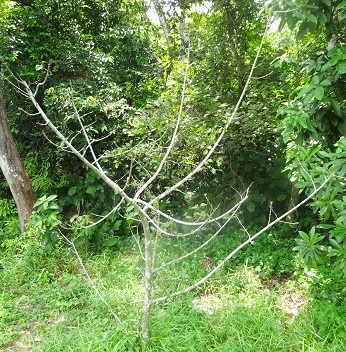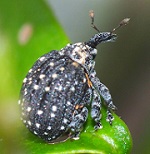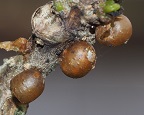| Home | Nature Weekly Index |
14 April 2019 | Mangrove Tree Weevil |
 This leafless treelet arose my interest when I visit a park on 23 March. There might be many various reasons
for a plant to shed all its leaves, voluntarily or involuntarily. In this instance, it is the latter scenario.
After walking closer to examine the treelet, it was without doubt that the defoliation was the work of a weevil.
More specifically, the nymphs of this weevil should be the primary suspect. Several of the weevils could be
found on different parts on the leafless branches. There were far more nymphs on the treelet and they were
mostly located on the few remaining leaves on this treelet.
This leafless treelet arose my interest when I visit a park on 23 March. There might be many various reasons
for a plant to shed all its leaves, voluntarily or involuntarily. In this instance, it is the latter scenario.
After walking closer to examine the treelet, it was without doubt that the defoliation was the work of a weevil.
More specifically, the nymphs of this weevil should be the primary suspect. Several of the weevils could be
found on different parts on the leafless branches. There were far more nymphs on the treelet and they were
mostly located on the few remaining leaves on this treelet.


 The small rounded weevil is black in colour with white to light-brown spots arranged in an orderly manner on
the top part (elytron) of its body. Its nymph is elongated, dark brown in colour and has a shiny surface. It
probably belong to the Family Curculionidae and Subfamily Cryptorhynchinae. On some leafless branches, there
were some mid-size egg-like structure attached. They might be the eggs of this weevil.
The small rounded weevil is black in colour with white to light-brown spots arranged in an orderly manner on
the top part (elytron) of its body. Its nymph is elongated, dark brown in colour and has a shiny surface. It
probably belong to the Family Curculionidae and Subfamily Cryptorhynchinae. On some leafless branches, there
were some mid-size egg-like structure attached. They might be the eggs of this weevil.
 Weevils are beetles belonging to the superfamily Curculionoidea. Most weevils are placed in the family
Curculionidae, often known as the true weevils. They can be easily distinguished from other group of minibeasts
by their long snouts. A good portion of information that you get from the Internet on Weevil will be on ways
to get rid of them since a number of them are pest of grains such as rice and maize.
Weevils are beetles belonging to the superfamily Curculionoidea. Most weevils are placed in the family
Curculionidae, often known as the true weevils. They can be easily distinguished from other group of minibeasts
by their long snouts. A good portion of information that you get from the Internet on Weevil will be on ways
to get rid of them since a number of them are pest of grains such as rice and maize.
The treelet happened to be a mangrove plant, Mangrove Trumpet Tree (Dolichandrone spathacea). There were a few matured trees in a different area of this park. This treelet was the only Mangrove Trumpet Tree in this area, positioned just by the side of a rocky embankment of a mangrove stream that flow toward the sea. The treelet is likely to re-grow its leaves after the weevil population dwindle. At my most recent visit on 6 April, the number of adult and nymph weevils had significantly reduced compared to my earlier visit. Some new leaves had emerged on a few branches
I recalled another unusual red coloured weevil that I saw in this same park back in May 2017. Since there was no pictorial reference specific to weevil in Singapore, the actual identity of the 2 weevils will continue to be a mystery.
Update: 28 June 2020
The weevil is likely to be a Cionus species from the subfamily Curculioninae. Cionus is supposed to be a genus from the Palaearctic realm. The genus has 61 species recognized at this point [1]. An earlier publication in 1999 indicated 60 known species of the genus and they inhibit mainly the Palaearctic and Ethiopian regions [2]. Ethiopian region is also called Afrotropical realm. Southeast Asia where Singapore is located belongs to the Indomalayan realm.
References:
[1] Košťál M, Caldara R. Revision of Palaearctic species of the genus Cionus Clairville (Coleoptera: Curculionidae: Cionini). Zootaxa. 2019;4631(1). | Read abstract |
[2] Lachowska D. Chromosome survey in seven bisexual species of weevil (Coleoptera, Curculiolidae). Folia Biologica (Krakow) 1999;47(3-4):111-113.